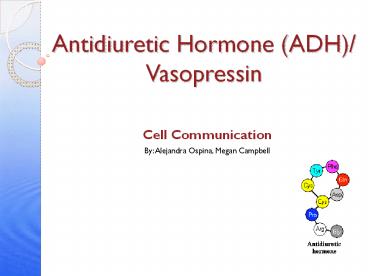Antidiuretic Hormone (ADH)/ Vasopressin - PowerPoint PPT Presentation
1 / 13
Title:
Antidiuretic Hormone (ADH)/ Vasopressin
Description:
Antidiuretic Hormone (ADH)/ Vasopressin Cell Communication By: Alejandra Ospina, Megan Campbell General Information ` Controls body water and solute concentration The ... – PowerPoint PPT presentation
Number of Views:787
Avg rating:3.0/5.0
Title: Antidiuretic Hormone (ADH)/ Vasopressin
1
Antidiuretic Hormone (ADH)/ Vasopressin
- Cell Communication
- By Alejandra Ospina, Megan Campbell
2
General Information
- Controls body water and solute concentration
- The function of several hormones act on the
kidneys and vascular system - Also known as Arganine Vasopressin
- Produced by neurosecretory cells in the
hypothalamus - Regulated by osmotic and volume stimuli
- Water deprivation increases osmolality of plasma
which activates hypothalmic osmoreceptors to
stimulate ADH release
3
Gland
- Secreted from the posterior pituitary gland
- The hypothalamus sends signals to the pituitary
gland to secrete the hormone. - Once hormone is secreted it goes to the kidney to
put its purpose into effect.
4
Base Structure
- 9 amino acid structure sequence
- Peptide based hormone
- Hydrophilic will not go into the cell
- Binds with the receptor on the cells surface
- Six of the amino acids form a ring structure,
joined by disulfide bonds.
5
Pathway Messenger
- Vasopressin is released and binds to cell
membrane at receptor - Binding results in ATP breaking down to cAMP
- cAMP is the second messenger
- cAMP activates PKA which synthesizes aquaporin
- Aquaporins bind in the membrane and let H20 into
the cell - Does not directly communicate with nucleus
- Indirectly communicates with cytoplasm and cell
membrane.
6
Pathway continued
- The receptor is linked to adenylyl cyclase (AC)
- enzymes via heterotrimeric G proteins in the
membrane - thus, AC is activated as a consequence of VP
binding to its - V2 receptor resulting in the formation of the
second - messenger cyclic AMP. Subsequent phosphorylation
of - protein kinase A is associated with the final
step of water - reabsorption. Cyclic AMP is rapidly degraded to
5-AMP - by intracellular phosphodiesterase enzymes.
7
Pathway Diagram
VP-vasopressin AQP- aquaporin PKA- protein kinase
A
8
Cellular Response
- Once cAMP is rapidly degraded by intracellular
enzymes, thus the insertion of water channels
into the membrane of the target cell, mediates
rapid cross-membrane water transport. - There is also an increased movement of
aggraphores towards these membranes. - The response is an increase of water absorption.
- Not a transcription factor
- It does turn an enzyme (protein kinase A)
- There is no conformational change expect the
introduction of more aquaporins into the
membrane.
9
Positive or Negative Feedback?
- Negative Feedback
- Decreased water levels in body resulting in more
ADH production- increased thirst- will increase
the amount of aquaporins being added in increased
as well (to reabsorb more water into the kidney) - Increased water levels result in a reduced ADH
production telling the kidney to reabsorb less
water.
10
Consequences of Disruption
- When ADH is inhibited, water will not be
reabsorbed at the tubules and the body will
produce dilute urine. - Hyponatremia (not enough sodium (salt) in the
body fluids outside the cells.) and
hypo-osmolality resulting from inappropriate,
continued secretion of the hormone despite normal
or increased plasma volume, which results in
impaired water excretion. - Symptoms Confusion, disorientation, delirium,
generalized muscle weakness, myoclonus, tremor,
asterixis, hyporeflexia, ataxia, dysarthria,
Cheyne-Stokes respiration, pathologic reflexes,
generalized seizures, coma - Incontinence- involuntary urination Common in
elderly people. - Lack of ADH at night leads to bladder overfilling
and thus urination.
11
Consequences of Disruption Continued
- Syndrome of inappropriate
- antidiuretic hormone
- secretion is also known as SIADH.
- It is a condition where
- your body makes too
- much antidiuretic
- hormone (ADH).
- Increased ADH makes water remain inside your
body, causing other chemicals in the blood such
as salt may decrease. - Organs may not function properly
12
Consequences of Disruption Continued
- Hyperosmolality
13
Works Cited
- http//www.vivo.colostate.edu/hbooks/pathphys/endo
crine/hypopit/adh.html - http//joe.endocrinology-journals.org/content/159/
3/361.full.pdf - http//images.google.com/
- http//emedicine.medscape.com/article/246650-overv
iew - www.uic.edu/classes/phyb/phyb402dbh/lecture4.ppt
- http//www.drugs.com/cg/syndrome-of-inappropriate-
antidiuretic-hormone-secretion.html































